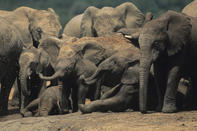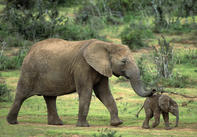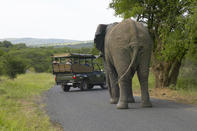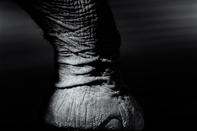Sensitive Beasts

Elephants are among the four animals in the bush you don't want to confront, the others being lion, rhino and buffalo. It's not that elephants are aggressive or mean- spirited, they're just sensitive beasts with a lot of body weight to make their point. A breeding herd is potentially the most dangerous because it comprises a gang of overprotective mothers with their youngsters.
What you soon realise, after a day or two in the bush, is that besides the occasional lone bull or small bachelor herd, the only other kind of elephant you will encounter is one in a breeding herd. These mostly all-girl groups stick together under the nurturing trunk of their matriarch, which is usually the oldest and most experienced elephant and most likely related to all the younger animals in the group.
Mentors Needed

A recent situation at Hluhluwe- iMfolozi Park revealed social behaviour in elephants that is unnervingly like human nature. A herd of youngsters was relocated into the park. Without older bulls or a matriarch to fashion their social skills, they became delinquent.
They frequently squared up with rhino, many times even to the death, and were extremely discourteous when encountering people or cars. Realising the importance of having mentors for the next generation, mature animals have since been introduced to iron out the social dysfunction among the youngsters. Males leave the herd at sexual maturity but share the nurturing tendency - bachelor herds are also known to take in orphans.
Elephant Camp, a commercial venture outside Victoria Falls, recently found a new baby mingling with its domesticated herd. Staff discovered that the baby had been delivered by a lone, wild bull which had dropped him off like an old traveller leaving a stray at the doors of an orphanage. He simply wandered in with the baby, introduced it to the herd, and wandered off again.
So close are the familial bonds between elephants - to the point where they even seem to recognise the bones of their dead - that culling no longer involves picking off one or two animals in a group. An entire herd has to be killed to save the remaining animals the trauma of loss.
Characteristics of Elephants

While in the bush, watching a small herd of elephant trundle past in single file a short distance away. Suddenly the leading lady picked up our smell on the breeze. The entire line came to a perfect halt. Then, as if to military command, they turned on their left back foot and marched off in formation.
It was too organised and precise to have been one elephant copying the body language of another. For a long time, people thought there had to be something behind this almost telepathic behaviour. In the 1980s it was found that elephants can indeed communicate in a way we cannot detect. They emit deep, long-wave sounds, below the range of human hearing, which can travel as much as 4 km, if not further, when weather conditions permit.
So while they appear to be silent, they are actually rumbling and purring to each other constantly and you will feel it, rather than hear it. So when our ears registered the bellowing of stampeding elephants, they missed a far more colourful spectrum of sound as the animals veered away from us as one.
Great Grey Ghosts

The feet of elephants are the latest body part to attract scientific interest. In spite of carrying up to seven tonnes around for sixty-odd years, their feet are incredibly sensitive. The sole is padded with soft, pliable cartilage that cushions the foot with each step. Instead of the click-clack we are accustomed to from hoofed animals, an elephant's gigantic footstep is virtually undetectable.
This is why elephants melt in and out of the bush with uncanny quiet, winning them the name in these parts of the great, grey ghosts. Some scientists are even beginning to think that elephants may be able to use their sensitive soles to read their environment. Elephants have often been seen rolling unfamiliar objects gently under a front foot, as a blind person would finger Braille. A team of Stanford scientists are taking this a step further.
They believe elephant infrasound may even be transmitted seismically through the ground and that the animals may be able to 'read' these sounds, transmitted to the ears through bones in the foot and toenail. This theory has yet to be tested, but scientists are broadcasting recorded infrasound seismically across elephant country in Namibia to see if the animals respond.